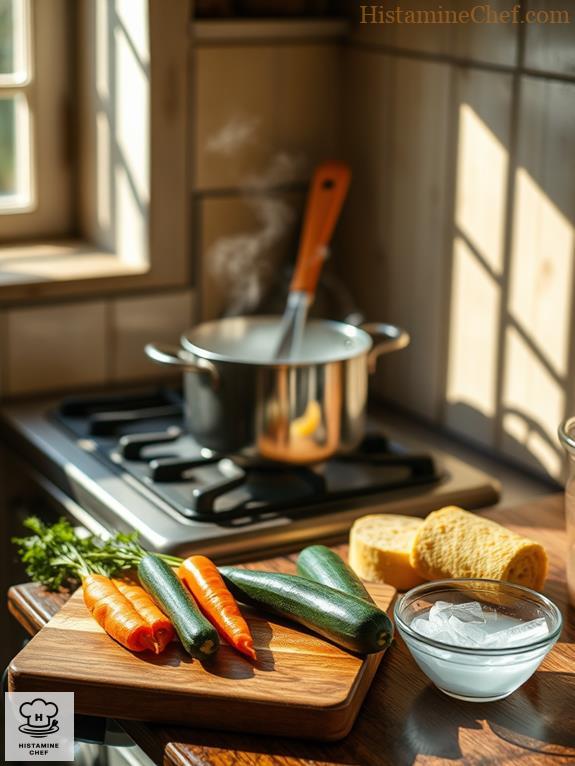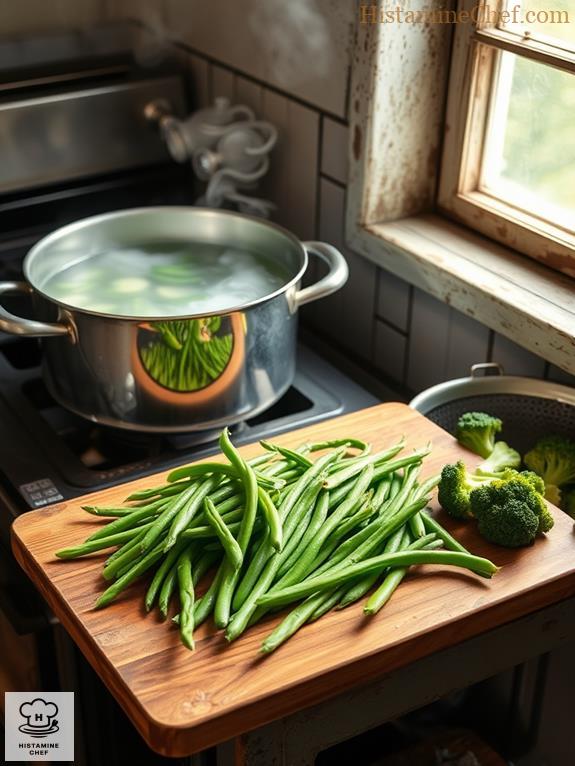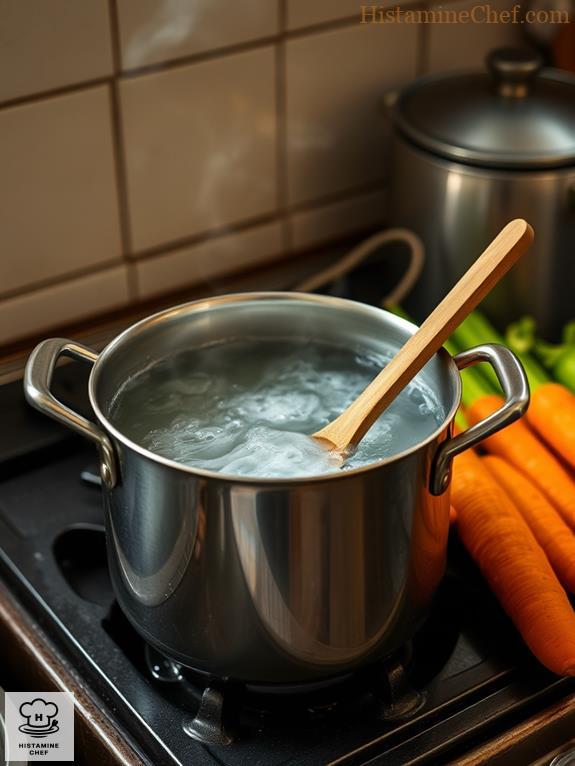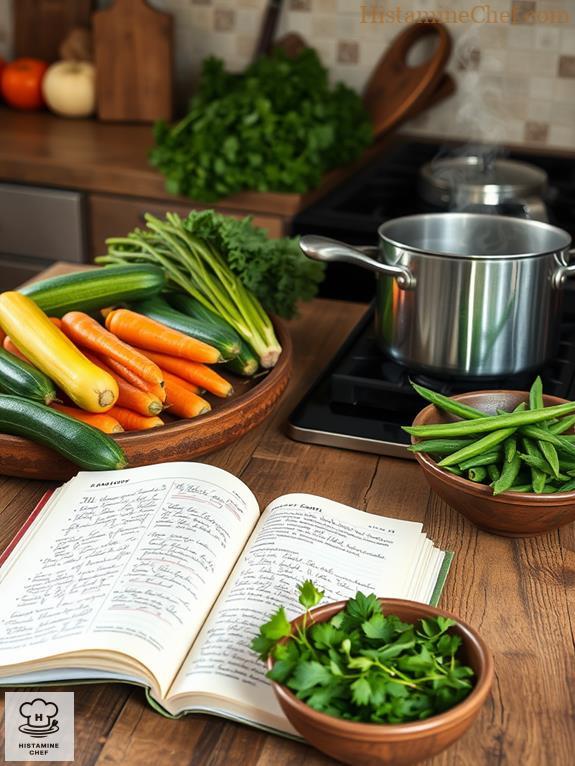Ever wondered how to make histamine-safe meals that actually taste good? I've cracked the code!
I'm all about blanching and boiling for low-histamine cooking. It's a game-changer, trust me.
Here's my secret: I grab veggies like carrots and zucchini, then give 'em a quick dip in boiling water. We're talking 2-3 minutes, tops.
For boiling, I keep it gentle. No need to anger those histamines, right?
Fresh herbs are my best friend here. They add a flavor punch without the histamine drama.
Timing is everything, folks. Quick and gentle is the name of the game.
My Histamine-Safe Cooking Mishap: A Lesson Learned
Let me tell you about the time I messed up big time. I was hosting a dinner party and decided to go all fancy with a slow-cooked stew.
Big mistake! I forgot about histamine build-up during long cooking times. Halfway through the meal, my face was redder than a tomato.
Talk about embarrassing! That's when I realized the importance of quick cooking methods for us histamine-sensitive folks.
Lesson learned: stick to blanching and boiling for happy tummies and itch-free nights!
Key Takeaways
- Select low-histamine vegetables like carrots, zucchini, and bell peppers for safe blanching and boiling.
- Blanch vegetables in boiling water at 212°F (100°C) for 2-3 minutes to maintain texture and nutrients.
- Immerse blanched vegetables in ice water immediately to preserve crunchiness and flavor.
- Boil vegetables gently to minimize histamine release, avoiding vigorous boiling to protect food integrity.
- Store cooked vegetables in airtight containers and refrigerate promptly to prevent histamine buildup.
Understanding Histamine and Cooking

Understanding histamine and how it interacts with food is essential for anyone managing histamine intolerance.
You see, histamine sources are sneaky! They can hide in foods we love, from aged cheeses to certain fruits. Cooking methods play a huge role in how much histamine our meals pack.
For example, did you know that heating can increase histamine levels in some foods? It's like a sneaky party crasher!
Smart cooking techniques can help reduce histamine content in your meals, making them safer for those with histamine intolerance.
So, when I whip up a meal, I stick to the SIGHI list. I choose fresh veggies, fresh meats, and avoid pickled or processed options.
Trust me, it feels great to savor a meal without worrying about histamine levels.
Join me on this journey at Histamine Chef, where we explore safe and delicious cooking!
Blanching Techniques for Low Histamine

When it comes to blanching for low histamine cooking, I've found that choosing the right vegetables is key to keeping things safe and tasty.
You'll want to avoid those high-histamine offenders like spinach and tomatoes, but lucky for us, there are plenty of delicious options available!
Simple cooking techniques can make a big difference in managing histamine levels in your meals. Blanching is an excellent method for preserving nutrients while reducing histamine content.
Selecting Safe Vegetables
Selecting safe vegetables is essential for anyone managing histamine intolerance. The key is to focus on the SIGHI list, where allowed veggies shine bright, while the restricted ones, like tomatoes and spinach, are best left behind.
When you're diving into vegetable preparation, think fresh and vibrant! Carrots, zucchini, and bell peppers are your pals here. They not only taste great but also bring a splash of color to your plate.
As you explore cooking methods, blanching is a fantastic option. It locks in flavors while keeping those histamine levels low.
So, what's stopping you? Grab those safe veggies, and let's create a delicious, histamine-friendly masterpiece! After all, cooking should be fun, right?
Happy cooking from your friendly Histamine Chef!
Ideal Water Temperature
The ideal water temperature for blanching vegetables is crucial to maintaining their flavor and histamine levels.
I've found that keeping the water at a rolling boil, around 212°F (100°C), works wonders. This temperature guarantees that your veggies cook quickly, locking in their vibrant colors and nutrients.
Imagine dropping fresh green beans into that bubbling water; the sound is music to my ears! Just keep in mind, too high of a temperature might lead to mushy veggies, and nobody wants that!
When I started my journey with low histamine cooking, I realized safe cooking techniques like this make all the difference.
Using the SIGHI list, I can confidently choose the best veggies while keeping histamine levels in check.
Timing for Blanching
Timing is everything in blanching, especially for keeping histamine levels low.
You see, the blanching duration can make or break your vegetable texture! I've found that a quick dip of 2-3 minutes in boiling water works wonders.
Too long, and your veggies turn mushy—yikes! Envision biting into a limp carrot; not fun, right?
When you're aiming for that perfect crunch, it's all in the timing.
And recall, stick to those SIGHI-approved veggies, like carrots and zucchini, while steering clear of restricted ones like spinach or tomatoes.
Trust me, getting the timing just right can transform your meals!
Boiling Methods for Safe Cooking

Boiling has some fantastic benefits! When you boil vegetables, you're not just softening them; you're also reducing histamine levels.
Gentle cooking methods like poaching and boiling are excellent choices for those with histamine sensitivity. Envision vibrant carrots or green beans bobbing in a pot, ready to be enjoyed without the worry of histamine reactions.
Simply bring water to a rolling boil, toss in your SIGHI-approved veggies, and let them dance until tender! It's that easy.
And guess what? You can infuse flavor by adding herbs, making your meal pop with taste!
Selecting Suitable Ingredients

When it comes to cooking safely with histamine, picking the right ingredients is key!
I can't tell you how many times I've stared at a tomato and thought, "Why do you have to be so high in histamine?"
Smart substitutions can help you adapt recipes and find suitable alternatives for common high-histamine ingredients.
Let's explore some allowed vegetable choices, safe fruit options, and suitable starch selections that will help keep our meals both delicious and histamine-safe!
Allowed Vegetable Choices
With a careful selection of ingredients, I can guarantee that my meals not only taste great but also align with my histamine-safe cooking needs.
Choosing the right vegetables is key to revealing both flavor and health benefits. Here are my top three picks:
- Carrots – Crunchy and sweet, they add a delightful texture to any dish.
- Zucchini – Versatile and mild, it pairs beautifully with various flavors.
- Bell Peppers – Bursting with color and nutrients, they brighten up any plate.
Safe Fruit Options
Incorporating the right fruits into my diet is just as important as selecting safe vegetables. When I'm on the hunt for safe fruit varieties, I gravitate towards apples, blueberries, and peaches. These fruits not only taste delightful but also keep my histamine levels in check.
I love experimenting with fruit preparation methods, like tossing them in a salad or blending them into smoothies. It's amazing how a little creativity can transform simple fruits into something extraordinary!
Have you ever tried making a revitalizing fruit salad with pomegranate and nectarines? It's a game-changer!
Suitable Starch Selections
Selecting suitable starch options is essential for maintaining a low-histamine diet. Trust me, your tummy will thank you!
When it comes to starch varieties, I've found a few gems that work wonders in the kitchen. Here are my top picks:
- Quinoa – A protein-packed superstar that pairs beautifully with veggies.
- Sweet Potatoes – These sweet delights aren't only tasty but also versatile!
- Rice Noodles – Perfect for stir-fries or soups, they're a delightful texture!
Experiment with these starches using safe cooking methods like blanching or boiling. It's like playing chef without the histamine drama!
Keep in mind, the SIGHI list is your best friend here. So, what's your go-to starch? Let's explore the delicious world of low-histamine cooking together!
Timing and Temperature Considerations

When it comes to histamine-safe cooking, timing and temperature play essential roles in ensuring your meals remain safe and enjoyable.
I've discovered that blanching benefits include brightening colors and enhancing flavors without raising histamine levels. It's quick, so don't wander off! Just immerse those veggies for a couple of minutes, then plunge them into ice water.
Mastering cooking times is vital for histamine-friendly recipes, as it helps maintain nutritional value while minimizing histamine production.
Now, let's talk boiling advantages. Keep your pots at a gentle simmer; boiling too vigorously can break down your food and release histamine.
Speaking of which, recall those restricted foods on the SIGHI list? Avoid high-histamine villains like spinach and tomatoes. Instead, embrace low-histamine heroes like carrots and zucchini.
Cooking can be a delightful adventure—let's make it safe and delicious together!
Post-Cooking Storage Tips

After cooking, proper storage is essential to maintain the histamine safety of your meals. I can't stress this enough!
If you want to keep your delicious creations fresh and safe, follow these tips for effective post-cooking storage and fridge organization:
- Cool Down Quickly: Let your food cool to room temperature before stashing it away. This helps prevent bacteria from crashing the party!
- Use Airtight Containers: Invest in some solid containers. They keep odors in and pesky histamines out.
- Label and Date: Seriously, it's a game-changer! You'll know what's what and when it was made.
Keep these tips in mind to guarantee your histamine-safe meals stay fresh and tasty.
Happy cooking from your friendly Histamine Chef!
FAQ
Can I Use Frozen Vegetables for Blanching Safely?
Absolutely, I find frozen vegetable safety quite impressive! When I blanch, I prefer methods that preserve nutrients while ensuring quality. It's an innovative way to enjoy fresh flavors without compromising on health or taste.
How Does Cooking Time Affect Histamine Levels in Foods?
I've found that cooking time greatly impacts histamine levels in foods. Using innovative cooking methods for food preservation can help manage histamine content, ensuring delicious meals while catering to my dietary needs.
Are There Specific Utensils to Avoid When Cooking Low Histamine Meals?
When cooking low histamine meals, I avoid reactive utensil materials like copper and non-stick coatings. Instead, I choose safe cookware made from stainless steel or glass, ensuring my meals remain as fresh and innovative as possible.
Can I Re-Blanch Vegetables if They Were Not Cooked Long Enough?
I've found that re-blanching vegetables can improve their texture considerably. For ideal blanching, I suggest timing it right to maintain crispness while ensuring they're fully cooked. Experimenting with different techniques always leads to innovative results!
What Are the Signs of Histamine Intolerance After Eating Cooked Foods?
Oh, the joys of a gourmet meal gone wrong! If I experience headaches, hives, or a rollercoaster stomach after eating, I know I'm facing symptoms of food sensitivity and must sharpen my symptom identification skills.
Summary
I love cooking histamine-safe meals using blanching and boiling techniques. These methods help me create flavorful dishes while keeping my histamine levels in check. By mastering these skills, I can enjoy vibrant, satisfying meals that are both safe and delicious.
What's your experience with histamine-safe cooking methods? Have you tried blanching or boiling to reduce histamine levels in your meals?
Please share this post on social media to help spread awareness about histamine-safe cooking techniques. Your support helps grow the Histamine Chef blog and reach more people who can benefit from this information.


Leave a Reply